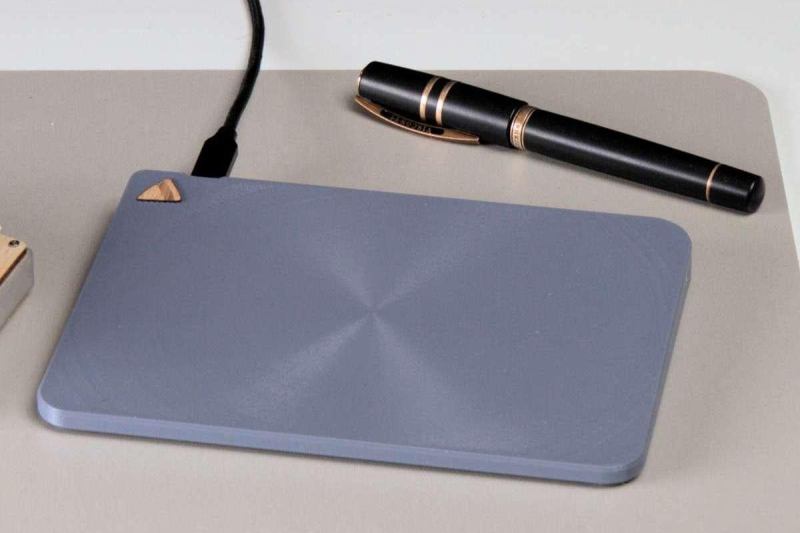Touchpads, or trackpads, have been around since the 1980s. Today, you can often find them in laptops and notebook computers as pointing devices. With no moving parts, a trackpad are easy to integrate into the body of a portable computer. they’re much smaller than the traditional mouse. Until the advent of multitouch and gestures over the past two decades, though, they were generally poor substitutes for an actual mouse. These days, trackpads have enough features that some users prefer them even on their desktop computers. If you’re that type of person and don’t want to shell out a big pile of money for an Apple, Logitech, or other off-the-shelf trackpad you can always build your own.
This trackpad, called the Ploopy, is completely open source, including the 3D prints needed to build the case. Even the touch surface is 3D printed, using a special sheet and printing the trackpad face down so that the surface takes on a smooth, comfortable texture. Inside the device is a Raspberry Pi Pico running QMK, a popular open-source firmware for mice and keyboards we often see on mechanical keyboard builds. The only part most of us won’t find in our parts bin is the Microchip ATMXT1066TD touchscreen controller. But once it’s all assembled and a firmware flashed to the Pi, it’s ready to go.
For anyone looking to build one of these from scratch there are a set of instructions at a separate page that document the build process. There’s also a Reddit thread with some active discussion. Trackpads have come a long way from the barely-usable, resistive types that were more common in the early days of laptops. Most of us have gotten used to the high-quality devices available now so much so that it’s hard to let them go. There are some other non-standard pointer devices that some others have a hard time letting go of, too.
















The article was good but I’m more curious about the pen next to the pad. Is it what I think it is? Very nice!
Visconti Homo Sapiens Fountain Pen
https://www.thepencompany.com/en-us/product/visconti-homo-sapiens-fountain-pen/
Yeah that caught my eye too. I think its a visconti homeosapian (bronze age i think?) very jealous!!!
Yikes, that’s a pricey pen!
Looks like a viscanti homosapiens
thanks to google search, it’s VISCONTI Homo Sapiens Fountain Pen
Okay, I’m a little confused here. (Not intended to criticize author or inventor)
This device will track large items such as fingers moving across the surface,
but will not have the resolution of something like a Wacom tablet?
I.e. stylus resolution.
But for my desk PC, it can replace the mouse for moving the cursor?
Yes. When they work correctly, capacitive trackpads used with fingers are like a direct brain-eye connection, at least for me. I have used them on Mac laptops as my only computer since 1999. Smooth, responsive
That being said, though, I have had nothing but frustration with trackpads on Windows laptops that I get assigned at work (the 2 biggest US windows computer brands). Clicks seem to make the cursor jump away from the point Im trying to click, almost every time I click on the trackpad. Very jarring to my work flow.
I have to wonder if Windows is the issue, or if it’s the manufacturer, because the System76 Linux laptop I have seems to not have that problem more than maybe one time in 20.
I have the same issue with Windows making hitting targets hard, I think it’s because it doesn’t handle the last part of targeting correctly. What would be wanted is when the finger moves slowly it should try to ignore sudden fast movement, which would be indicative of a finger changing the angle rather than a intended movement?
Well, the trackpad on my ThinkPad R400 (build date 2009-09-09) bugs me when it moves the cursor to a different line of text while I’m busy typing if I slightly brush against it.
It runs Linux.
This is basically just a laptop trackpad but in its own external enclosure. That used to be somewhat common as a desktop accessory, and Apple sells their own version of it to this day (the Magic Trackpad), but it’s never been all that popular as a desktop pointing device for whatever reason.
Personally I use a Magic Trackpad as my main pointing device and it’s great, but a little big and overpriced. If the Ploopy ever gets native macOS gesture support I’ll definitely be buying a few kits myself.
The 3dprinted surface looks like a fail, it’ll wear out, BUT, it is awesome idea. Key seem to be the custom sensor PCB, and those are possible to get made in oneof quantities, maybe even in 11 inch+.
I want to make a version with one of these chips:
https://www.microchip.com/en-us/products/touch-and-gesture/maxtouch-touchscreen-controllers/kod-family
and integrate rotary controls.
I’ve used my phone as a remote keyboard/touchpad with my Linux machine using KDE Connect. I wonder if connecting a tablet would let you connect it up like a streampad/interactive macropad?
Using a phone as a touchpad is a neat idea – I’ve played around with KDE Connect to move files back and forth, but haven’t tried the remote control feature.
How thin can one go ?
Is 4 mm an achievable goal ?
Can we ditch the top layer case and use the bare pcb ?
PTFE sheet maybe, something slick that does not wear out. Not sure how that would get glued to the pub.
“Ploopy?”
“Haaa-aannng on Ploopy!
Ploopy, hang on!
Is this an Anti vim thing?
Vim? Is this an anti-vi thing?
Worth noting that the company is named Ploopy, not the product. They make several other human computer interfaces, including mice and trackballs. They even have a pair of headphones, although I think the headphones are a misguided release. A topic for another day.